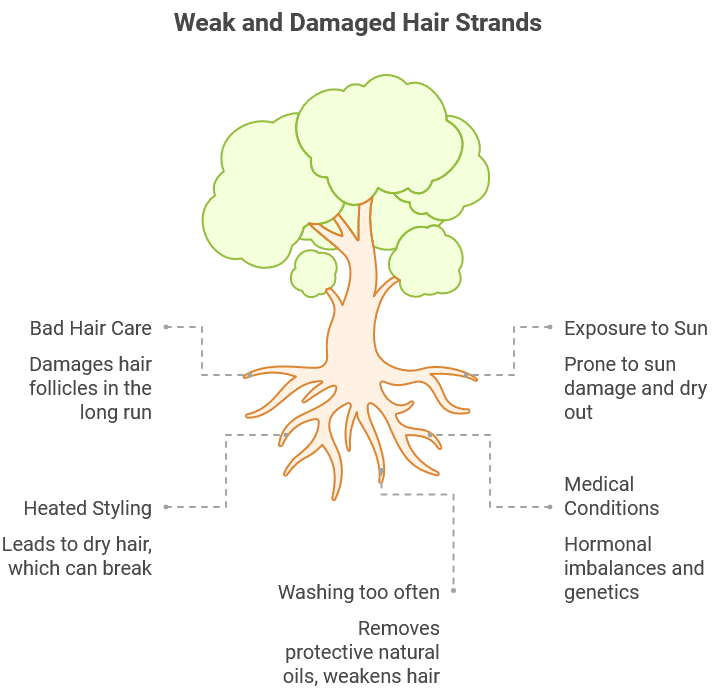Many TV commercials for shampoos and conditioners promise to give you stronger hair, but why does it matter so much?
Well, because the strength of the strands and roots is a good indicator of overall hair health. The weaker it is, the more prone it will be to breakage, and it will be thinner and frayed when you grow it longer. It will also be more prone to sun damage and dry out more easily.
With all this in mind, let’s go over some of the cause and effective solutions to this issue.
Did you know?
According to the 2025 ISHRS Practice Census, the average ISHRS physician treated 668 patients in 2024—156 surgical and 498 non-surgical—highlighting the growing demand for hair strengthening and restoration solutions worldwide
Common Causes of Weak or Damaged Hair
When people have weak hair, what you’ll usually find is that they also have some bad hair care habits and expose it to various external factors that can permanently damage hair follicles in the long run. These are just a few of the biggest risk factors you should avoid:
- Braids and other tight hairstyles;
- Frequent prolonged exposure to the sun;
- Aggressive brushing and towel drying methods;
- Stress, lack of physical activity, and an unhealthy diet;
- Medical conditions, hormonal imbalances, and genetics;
- Heated styling methods and chemical treatments or dyes.
Luckily, there are several things you can do to prevent thinning and hair breakage.

Step-by-Step: How to Strengthen Your Hair Naturally
If you are worried that your hair might be getting weaker and frayed, try the following tips to return its original resilience, the natural way.
1. Wash Less Often and Use a Conditioner
It’s a well-known fact that daily washing removes all the protective natural oils, which can weaken your hair and cause it to become dry. Try to wash it only 2–3 times per week, and use mild shampoos, followed by a good moisturizing conditioner.
2. Brush When Dry (Depending on Hair Type)
Running a brush through wet hair leads to more breakage, so avoid it and use a wide-tooth comb to gently detangle without ripping entire strands out. The opposite is true for curly hair, though, where it’s best to brush gently when it’s still relatively wet.
3. Minimize the Use of Blowdryers and Hot Irons
Using too much heat can lead to dry hair, which can break and fray more easily, so let it dry on its own, don’t go with styles that require hot irons and straighteners, and use a heat protectant product when blowdrying.
4. Apply Hair Masks Weekly
Leaving a hair mask in for 10–20 minutes after washing once a week is enough to help seal in the moisture and give you some additional protection.
5. Protect It From the Elements
A wide-brimmed hat is a simple and stylish way to protect your hair from the summer heat, but you can also apply some conditioner, especially when going to the pool, to keep the hair shaft safe against the chlorine in the water.
Strengthening Your Scalp: The Root of Healthy Hair
Of course, you should also take proper care of your scalp by eating more nutritious food, especially that with omega-3 fatty acids, vitamins A, E, and B7, as well as Zinc and Iron. This, coupled with scalp massages and natural oils like rosemary, jojoba, and castor, will lead to much healthier hair.
When Hair Loss Signals a Deeper Problem
Having thinner and weaker hair is one thing, but if you also notice excessive shedding, then it may be a more serious issue.
The characteristic signs of male pattern baldness are a receding hairline with thin hair at the front, while for women, it’s a gradual thinning and appearance of a balding line at the top of the head. If you notice these symptoms, it’s a clear sign that you need something more effective.
Hair Strengthening vs. Hair Restoration
If you are on the fence about which method to go with, here is a quick overview:
Feature | Strengthening | Transplant |
Difficulty | Simple, using natural ingredients | Requires a surgical intervention |
Benefits | Improves overall scalp health | Restores hairline and adds overall thickness |
Timeline | Slight improvements over several months | Impressive, natural-looking results within 8–12 months |
Cost | Low to moderate | Moderate |
Longevity | Daily effort required to maintain results | Permanent results with minimal care required |
Risk | Virtually none | Slight surgical risks and minimal scarring |
Best For | Early signs of thinning and weak hair | Increased area of thin hair, receding hairline, or bald spots appearing. |
As you can see, each method has some pros and cons, but in general, a transplant is a good long-term option for those experiencing more serious problems.
Hair Transplants: A Lasting Solution for Severe Hair Weakness or Loss
The natural methods we’ve mentioned above can only help so much, and if you have a genetic predisposition to baldness, you will need a more permanent solution. Getting a hair transplant in Istanbul is a fairly affordable way to get a full head of hair, with a youthful hairline and increased thickness and volume.
FAQs
Can weak hair be strengthened without medical treatments?
Yes! You can start with a healthier diet and massage natural oils like rosemary into the scalp. All this can help reverse some of the damage and add strength. All this can help reverse some of the damage and add strength.
Is my hair too weak for a transplant?
Even if the hair on top of the head is weak and thin, or you have noticeable bald areas, you can still be a good candidate for a hair transplant, just as long as the donor area at the back of the head has enough healthy follicles. It’s best to get a consultation with a specialized clinic to get a definitive answer.
What nutrients help with hair strength?
A daily dose of protein and omega 3, along with Iron and Zinc and vitamins A, E, and B7 should keep your hair strong and healthy.
When should I consider a hair transplant instead of natural methods?
If you’ve tried all the natural solutions and changed your diet and habits, but you still notice thinning and it keeps getting worse, e.g., your hairline has receded quite a bit or you start noticing bald spots, then it’s time to schedule a transplant.

